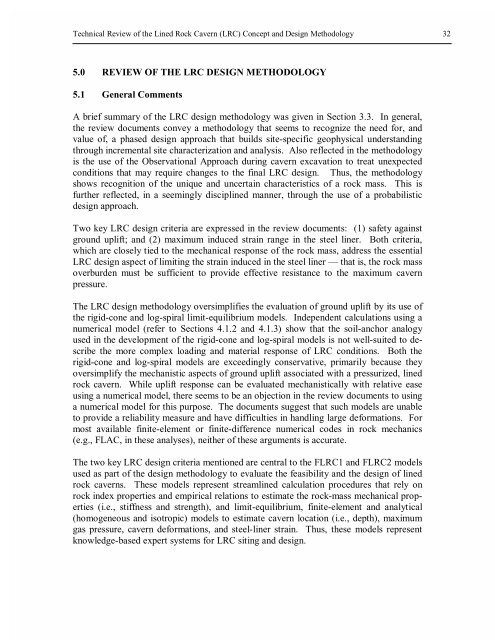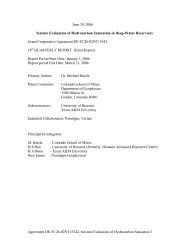Technical Review of the Lined Rock Cavern Concept and Design ...
Technical Review of the Lined Rock Cavern Concept and Design ...
Technical Review of the Lined Rock Cavern Concept and Design ...
You also want an ePaper? Increase the reach of your titles
YUMPU automatically turns print PDFs into web optimized ePapers that Google loves.
<strong>Technical</strong> <strong>Review</strong> <strong>of</strong> <strong>the</strong> <strong>Lined</strong> <strong>Rock</strong> <strong>Cavern</strong> (LRC) <strong>Concept</strong> <strong>and</strong> <strong>Design</strong> Methodology 32<br />
5.0 REVIEW OF THE LRC DESIGN METHODOLOGY<br />
5.1 General Comments<br />
A brief summary <strong>of</strong> <strong>the</strong> LRC design methodology was given in Section 3.3. In general,<br />
<strong>the</strong> review documents convey a methodology that seems to recognize <strong>the</strong> need for, <strong>and</strong><br />
value <strong>of</strong>, a phased design approach that builds site-specific geophysical underst<strong>and</strong>ing<br />
through incremental site characterization <strong>and</strong> analysis. Also reflected in <strong>the</strong> methodology<br />
is <strong>the</strong> use <strong>of</strong> <strong>the</strong> Observational Approach during cavern excavation to treat unexpected<br />
conditions that may require changes to <strong>the</strong> final LRC design. Thus, <strong>the</strong> methodology<br />
shows recognition <strong>of</strong> <strong>the</strong> unique <strong>and</strong> uncertain characteristics <strong>of</strong> a rock mass. This is<br />
fur<strong>the</strong>r reflected, in a seemingly disciplined manner, through <strong>the</strong> use <strong>of</strong> a probabilistic<br />
design approach.<br />
Two key LRC design criteria are expressed in <strong>the</strong> review documents: (1) safety against<br />
ground uplift; <strong>and</strong> (2) maximum induced strain range in <strong>the</strong> steel liner. Both criteria,<br />
which are closely tied to <strong>the</strong> mechanical response <strong>of</strong> <strong>the</strong> rock mass, address <strong>the</strong> essential<br />
LRC design aspect <strong>of</strong> limiting <strong>the</strong> strain induced in <strong>the</strong> steel liner — that is, <strong>the</strong> rock mass<br />
overburden must be sufficient to provide effective resistance to <strong>the</strong> maximum cavern<br />
pressure.<br />
The LRC design methodology oversimplifies <strong>the</strong> evaluation <strong>of</strong> ground uplift by its use <strong>of</strong><br />
<strong>the</strong> rigid-cone <strong>and</strong> log-spiral limit-equilibrium models. Independent calculations using a<br />
numerical model (refer to Sections 4.1.2 <strong>and</strong> 4.1.3) show that <strong>the</strong> soil-anchor analogy<br />
used in <strong>the</strong> development <strong>of</strong> <strong>the</strong> rigid-cone <strong>and</strong> log-spiral models is not well-suited to describe<br />
<strong>the</strong> more complex loading <strong>and</strong> material response <strong>of</strong> LRC conditions. Both <strong>the</strong><br />
rigid-cone <strong>and</strong> log-spiral models are exceedingly conservative, primarily because <strong>the</strong>y<br />
oversimplify <strong>the</strong> mechanistic aspects <strong>of</strong> ground uplift associated with a pressurized, lined<br />
rock cavern. While uplift response can be evaluated mechanistically with relative ease<br />
using a numerical model, <strong>the</strong>re seems to be an objection in <strong>the</strong> review documents to using<br />
a numerical model for this purpose. The documents suggest that such models are unable<br />
to provide a reliability measure <strong>and</strong> have difficulties in h<strong>and</strong>ling large deformations. For<br />
most available finite-element or finite-difference numerical codes in rock mechanics<br />
(e.g., FLAC, in <strong>the</strong>se analyses), nei<strong>the</strong>r <strong>of</strong> <strong>the</strong>se arguments is accurate.<br />
The two key LRC design criteria mentioned are central to <strong>the</strong> FLRC1 <strong>and</strong> FLRC2 models<br />
used as part <strong>of</strong> <strong>the</strong> design methodology to evaluate <strong>the</strong> feasibility <strong>and</strong> <strong>the</strong> design <strong>of</strong> lined<br />
rock caverns. These models represent streamlined calculation procedures that rely on<br />
rock index properties <strong>and</strong> empirical relations to estimate <strong>the</strong> rock-mass mechanical properties<br />
(i.e., stiffness <strong>and</strong> strength), <strong>and</strong> limit-equilibrium, finite-element <strong>and</strong> analytical<br />
(homogeneous <strong>and</strong> isotropic) models to estimate cavern location (i.e., depth), maximum<br />
gas pressure, cavern deformations, <strong>and</strong> steel-liner strain. Thus, <strong>the</strong>se models represent<br />
knowledge-based expert systems for LRC siting <strong>and</strong> design.

















